Antenna amplifier for TV: operating principle and rules for choosing a TV antenna amplifier
To improve the signal of a television receiver in a city apartment, and even more so in a place remote from the repeater - in a village or in a country house, an antenna amplifier for a television is used. The device is small in size and affordable, and you can install it yourself if you choose the model wisely.
Let's look at the technical features of the devices and analyze the criteria for choosing an amplifier for home use.
The content of the article:
Why do you need a signal amplifier?
If the TV does not operate from cable or a satellite dish, it means that it receives the signal using a regular antenna - indoor or outdoor. The transmission process occurs as follows: towers relaying transmissions are installed at a certain distance from each other.
Household receivers - televisions - use an antenna to catch signals and convert them into video accompanied by sound.
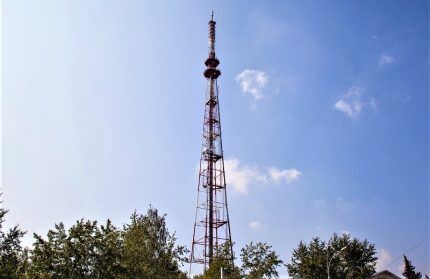
To stabilize and improve the TV signal, an amplifier is used for a home television antenna. Its importance increases where there is no common powerful receiver installed on the roof, that is, outside the city. The device helps to achieve maximum clear images on the screen and purity of sound due to the fact that it reduces interference.
Some antennas cope with signal transmission on their own, without connecting additional devices. Therefore, before purchasing, study the technical characteristics of the antenna and make sure that its capabilities are limited, and it is not possible to configure it to obtain high-quality image and sound without connecting a special device.
Operating principle of the antenna adapter
TV amplifiers are simple in design and can have different designs. Some consist of a pair of boards on which circuitry is implemented to reduce noise. One of the circuits performs the function of a high-frequency filter, the second is equipped with a capacitor for adjusting frequencies.
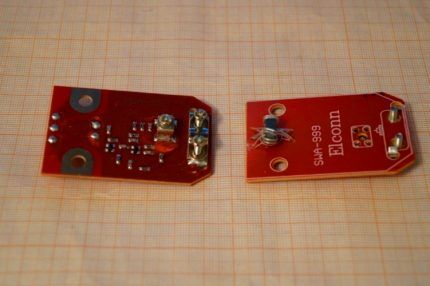
Thanks to the adjustment, a maximum signal gain of 4.7 dB can be achieved at an operating frequency of 400 MHz.
Some types of amplifiers are designed to be powered from a 12 V source, that is, they can be connected to a car battery. To achieve stability, a stabilizer is used, the circuit of which includes an electrolyte and a diode bridge.
A number of devices are connected using a coaxial cable, but using a choke. They are connected to the TV through a capacitor.
Let's look at the example of one of the transformer amplifier circuits to see how the device works. The module is powered via a signal cable.

C1 – a capacitor connecting the feedback section to the power supply and operating at low frequencies. R3 – a resistor that determines the stable operation of the amplifier in various frequency ranges. L1 – inductance that equalizes the frequency amplitude.
Feedback to flow is organized by the loop C3, R4, which together with R1 And R2 enable cascade operation mode. C2 – a capacitor that provides connection to the transformer.
The signal from the antenna enters the matching transformer, then is transmitted through a transistor, amplified and stabilized at the emitter. Then frequency correction occurs in the second stage of cascade transistors, after which the signal enters the TV.
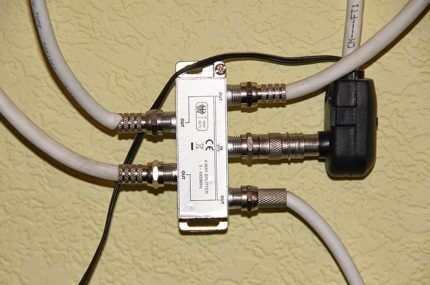
Thus, thanks to the television amplifier, the sensitivity limited by noise increases, and the loss of the received signal in the coaxial cable is compensated.
Types of television amplifiers
Devices are divided into categories most often based on two parameters: installation location and frequency range. This applies both to antenna amplifiers specifically and to related analogues - television and satellite.
According to the frequency range, there are three types:
- range;
- multi-band;
- broadband.
Range the device amplifies the signal only in a certain, specified frequency range - meter or decimeter. One of its functions is to reduce noise that appears as the cable length increases.
Multi-band devices operate with equal efficiency in different frequency ranges and can also receive signals from multiple sources.
Broadband The amplifier operates in the meter and decimeter ranges and is used for digital television.
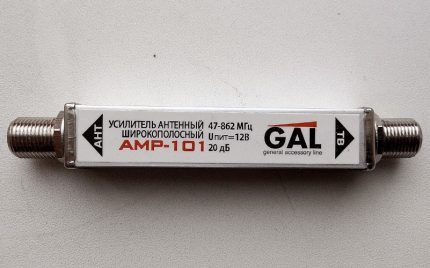
According to the installation location, all devices are divided into external (mast) and internal. External ones are mounted in the place where the television antenna is installed - on a pole or mast fixed to the balcony or roof. They feature durable protection.
Internal amplifiers are located close to the receiver. Their disadvantage is the losses associated with the cable length.
Selection criteria when purchasing
The choice of a signal amplifier for a TV antenna depends both on the technical criteria of the device itself and on external factors, such as the location and installation conditions. However, in the first place are always the characteristics that affect the quality of the signal - this is what additional devices are usually purchased for.
Criterion #1 – operating frequency range
The frequency range connects three devices - the television receiver itself, the antenna and the amplifier. First, select the antenna. It should be remembered here that wide-range ones are inferior to narrow-beam ones, that is, the signal will be weaker.
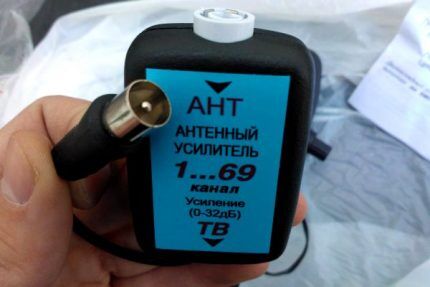
If the reception area is not far from the repeater, then you can purchase an “all-wave” unit that covers a wider range. However, a signal from a remote tower will be better received by a device designed for a limited frequency range - for example, HF or UHF.
The amplifier is also selected based on the frequency response of the antenna. If it does not match the range, it will not work.
Criterion #2 – noise figure
The antenna amplifier must adjust the signal-to-noise ratio upward. However, each device receives its own noise during data transmission - and the stronger the signal, the more pronounced it is.
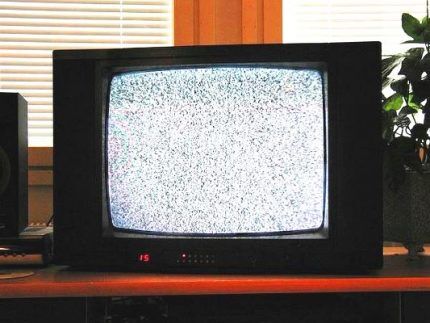
It is believed that the noise level should not exceed 3 dB - this is the only way to guarantee good signal transmission quality, but the latest generation devices also have lower values - less than 2 dB.
Criterion #3 – gain
You should not assume that the higher the signal gain, the better the transmission quality. In fact, excessive gain leads to signal distortion, which causes the opposite effect - clipping or overload.
The parameter is measured in dB and has average values:
- decimeter – 30-40 dB;
- meter - 10 dB.
Thus, decimeter ones can cover both 22 and 60 channels, and meter ones can cover no more than 12. If the amplifier increases the coefficient by 15-20 dB, this is considered a good result.
When choosing an amplifier by coefficient, it is necessary to take into account the actual conditions and reception level. Usually they focus on the distance to the tower, that is, the repeater.

To avoid getting into trouble, you can choose a device with the ability to adjust and make additional adjustments. There are many universal models, and they are designed for different distances.
If the tower is in direct line of sight, an amplifier is not needed.
Criterion #4 – active or passive
If we consider the principle of operation of the device, then we need to take into account the division into active and passive. The passive one operates in autonomous mode, while the active one requires additional power from the mains. Most often, the device is connected via an adapter - a 9 V or 12 V adapter.
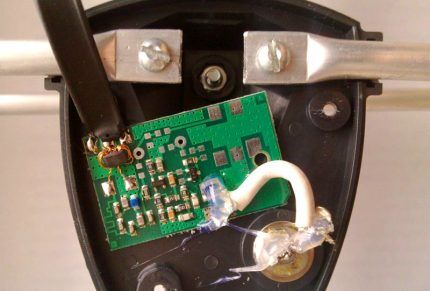
If the device is located outdoors, it is necessary to provide protection from moisture and precipitation. Sometimes the following option is implemented: the antenna with an amplifier is installed outside, and the adapter is left inside the room.
But it is better to follow the manufacturer's instructions, which usually warns of interference if installed incorrectly.
Review of popular models
Some amplifiers are in demand due to their simple design, low cost and easy installation. If necessary, the devices can be installed, replaced or repaired yourself.
When purchasing devices for external use, take care of their tightness. It has been noted that external devices have to be replaced approximately once every 2 years, despite their protection, so if it is possible to install the amplifier under the roof, take advantage of it.
Conclusions and useful video on the topic
The main thing about popular amplifiers:
Review of universal broadband devices:
If the image on the TV screen is “snowy” or completely crumbles into pixels, we recommend improving the quality of signal reception using a home TV antenna amplifier. Difficulties with self-connection usually do not arise if you strictly follow the manufacturer’s advice and take into account the characteristics of the antenna and device.




They gave me a second TV. They decided to put it in the kitchen. We bought an antenna with an amplifier, but it did not work. We returned it to the store and took another one. The result is the same. After placing the TV in another room and connecting it to the same antenna, it finally started working. As we understand, the amplifier does not respond well to equipment working nearby. Is there any way to solve this and protect the amplifier? It is not possible to rearrange the hood and electric stove.
It is possible that it is not even a matter of interference that electrical appliances operating in the kitchen can create. One of the obvious reasons is the low voltage coming from the outlet (extension cord) in the kitchen.
The reason is tritely simple - many devices are connected to one line, so the voltage drops and the amplifier simply does not have enough normal value for correct operation. Confirming or disproving this assumption is quite simple: turn off all appliances in the kitchen and connect the amplifier.
It is also possible that some equipment is causing interference, in which case you need to connect the amplifier in another room and extend the wire to connect the antenna to the TV directly in the kitchen. This is the optimal solution if it is not possible to move the equipment that creates interference.
At our dacha, the TV has difficulty picking up 2 channels; we can’t do it without an amplifier. Now I'm trying to figure out which one to buy...
First, try something simple, for example, I bought AMP-102 from Leroy Merlin. In most cases it will be enough. Although a lot depends on how far the dacha is from the repeaters.
I will offer several solutions for a country house, from simple and cheap to more complex and a little more expensive.
The first solution is a cheap antenna amplifier SWA-99999 (price about 1 dollar in total). The amplifier is installed inside the antenna box of the “Polish grid” type or similar.
The second option is the Locus LA-21 antenna amplifier, which costs about 4 dollars. The amplifier housing is designed in such a way that F-type connectors provide easy installation into a cable break; power is supplied through a stabilized source via a coaxial cable.
The third option is a home TV signal amplifier Bi-Zone BI-330, costing about 15 dollars. This is a solution for a summer house that is located at a great distance from the signal source.